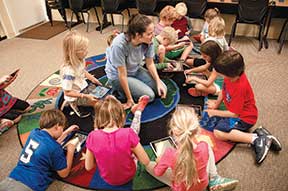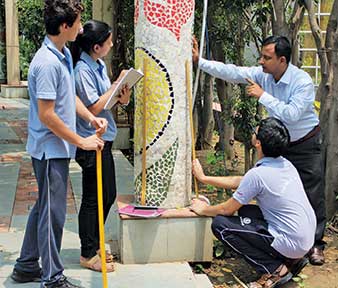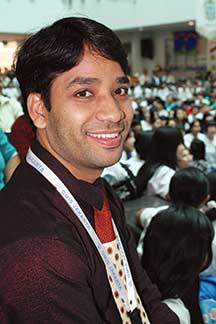Ankita Rajasekharan
The International Baccalaureate (IB) curriculum is a world curriculum practiced across many countries. In recent years, India – along with many other countries – has seen a rapid rise in the number of IB schools; children, parents, and teachers have shown a positive and enthusiastic response. What makes the IB curriculum different from what is otherwise available in the area of school education? How is it that a world curriculum seems to strike a great balance across diverse countries, communities, and cultures? What makes IB teachers stand out from the rest and what does it really take to be an IB teacher? These questions were explored in conversation with four IB teachers/coordinators from different countries – The United States of America, China, Indonesia, and India.

The uniqueness of the IB curriculum
The IB curriculum provides students and teachers a creative educational space to interact with, explore, and grow in. All participants, be it a teacher or a student, are learners, with a zest for inquiry and exploration. Almost all teachers stated that the IB curriculum comes with an extremely solid and strong educational research foundation. As stated by Kathryn McElavaney, a coordinator in the US, what sets the IB curriculum apart is its balanced approach of working with the whole child in all areas including academic, social, emotional, cognitive, and physical aspects along with a transdisciplinary and action-oriented learning pedagogy. Theory of Knowledge (ToK) is another unique aspect of the IB curriculum; it gets the child to think about what knowledge is and what it means to acquire knowledge. Brian Lalor, a coordinator from China further adds that constructivism and inquiry further guide how teaching and learning take place in an IB class. Peer and collaborative learning is strongly encouraged! Children are provided with opportunities to learn from one another and the extended community, resulting in research and drawing parallels to real life as a strong medium of learning, as pointed out by the teachers from India and Indonesia.
 Being an IB teacher
Being an IB teacher
The International Baccalaureate Organizations conduct regular and periodic workshops and training programs to strengthen and develop the IB teachers. They have what is called a Professional Learning Community and these groups meet periodically to share, exchange, and learn about one another’s work and experiences with the IB curriculum. The frequency and schedule of when these meets happen vary across countries based on their respective requirements and academic calendar. Often, the PLC chooses a specific theme that will be the focus of observations, discussions, and sharing; for example, the school in China chose to focus on ‘Inquiry’ as a theme for consecutive PLC meetings. There is also on-site training that happens in each school, again frequency and schedules vary; Santanu Bhowmik, a teacher from India explained that his school conducts these in-house trainings and discussions every Thursday. IB teachers are connected not only to their home country teachers but have an international IB network as well! They often share and discuss using the Internet as a forum; as mentioned by Lalor, the #pypchat forum on Twitter has gained popularity among the IB teachers as a platform to share and gather from experiences of other IB teachers across schools within the country and beyond.
 Just as collaborative learning is a guiding principle in the IB classroom, so is collaborative teaching. This implies that teachers don’t rely on a single textbook as a guide to what happens in the class; “IB provides vast learning and teaching opportunities for which I can’t be depending on just one resource. I have to go through various resources to facilitate and teach students; various resources such as books, websites, online books, media tools, fact sheets, documentary, field observation, Ted talks and YouTube videos are used in teaching and learning,” as stated by Manish Semwal, a teacher from Indonesia. This further implies that an IB student is never working with surface level concepts and ideas, they are digging deeper and thinking in more abstract terms. As stated by Bhowmik, “What is more interesting about mathematics education in IB is that the students are not expected to memorize formulae; instead, a booklet consisting of all the necessary formulae and a graphic display calculator is provided to them even during examination. Now, one can imagine that if these two tools are given, then the expectation is much higher than just getting some numerical solved by them.”
Just as collaborative learning is a guiding principle in the IB classroom, so is collaborative teaching. This implies that teachers don’t rely on a single textbook as a guide to what happens in the class; “IB provides vast learning and teaching opportunities for which I can’t be depending on just one resource. I have to go through various resources to facilitate and teach students; various resources such as books, websites, online books, media tools, fact sheets, documentary, field observation, Ted talks and YouTube videos are used in teaching and learning,” as stated by Manish Semwal, a teacher from Indonesia. This further implies that an IB student is never working with surface level concepts and ideas, they are digging deeper and thinking in more abstract terms. As stated by Bhowmik, “What is more interesting about mathematics education in IB is that the students are not expected to memorize formulae; instead, a booklet consisting of all the necessary formulae and a graphic display calculator is provided to them even during examination. Now, one can imagine that if these two tools are given, then the expectation is much higher than just getting some numerical solved by them.”
Contextualizing the IB world curriculum
Much of the standards, syllabus, and pedagogy of the IB curriculum is set globally; in consultation and collaboration with representatives from the different countries. While the global standards guide the schooling across countries, schools have the freedom and exercise this liberty as a definitive to ensure that local histories, cultures and knowledge are not ignored but are made an integral part of the IB student’s schooling. For a given concept, the concept is first understood and studied at the community level and then progressively moved to the global level. As shared by McElavaney, “A unit of the migrations of human people includes a historic look at immigration to the US, but also a modern look at refugees, specifically those that come into our state.” Lalor further supports this with the statement, “We feel that the host culture is an incredible teaching resource. In the past month alone, our students have visited local museums, a local orchard, park, and pagoda. Living in Xi’an makes this easy too as the city is one of the most ancient cities in the world. Being the start of the Silk Road, our units often contain links to Xi’an and the Tang Dynasty. Xi’an was also the ancient capital of China. We celebrate the Chinese New Year with a big performance and art display as well as the lantern festival.” They further have a strong Chinese Department in the school which meets weekly and collaborates with the home-room teacher to ensure local knowledge forms find their space in the student’s learning. Similarly, in India, “We have also taken our students to Jantar-mantar, Delhi to explore the mathematical intricacies involved and how mathematicians in those days used to calculate and accurately predict the solar eclipse. Celebration of Ramanujan’s day is yet another opportunity to understand his work and contribution. We have had students doing plays on how Ramanujan and Dr. Hardy came out of the Ramanujan-Hardy number,” says Bhowmik. And then, there is the aspect of being inclusive of the students who belong to diverse nationalities, gathered under the roof of a given IB school, there is a conscious effort to acknowledge, study and encourage their respective diversities; as stated by Semwal, “In our school, we celebrate Independence days of more than 40 countries as students from these countries study in our school. We celebrate Chinese week, French week, Indonesian Week, Hindi Week, Kartini day, UN Day, Mahatma Gandhi Lecture, etc., which make us a truly international school.”
The IB curriculum then, emphasizes collaboration and strong teacher training; further, it is grounded in continuing in-depth educational research, which finds its reflection in what we understand as the IB world curriculum.
The author is currently working as a facilitator at Shriram Montessori School, Hyderabad. She can be reached at 27.ankita@gmail.com.
